The curtain has been a trending leitmotif in the oeuvre of many artists working today. Whether in painting, sensually depicting drapery in an almost trompe-l’oeil manner, or in three dimensions in the form of sculpture and installation, the curtain and the use of heavy drapery, in general, have been pertinent motifs among contemporary artists. As a result, in this article, we will examine the curtain by briefly discussing its use and meaning throughout art history, followed by ten must-know artists revisiting the curtain today.
There is something inexplicably appealing to painting a curtain or seeing a well-painted curtain. The satisfying act of painting a curtain wet in wet with oil paint—and the fact that it is actually a lot easier than one might think—and the sensuality of the replicated soft texture, making it look almost tangible, have been exciting for artists and art enthusiasts for decades now. Think of the heavy drapery of the Virgin Mary with Jan van Eyck (1390-1441) or the eternal quest for mimesis—the re-presentation of nature and reality—which has its roots in Ancient Greece replicating the folds of the Chiton tunics in bronze and marble, before being emulated in Michelangelo’s (1475-1564) pieta or Giovanni Strazza’s (1818-1858) veiled virgin.
The master can showcase skill in depicting fabric. But even more, beyond awing the viewer, it can also deceive, as we perceive something as fabric or soft while simultaneously it is pigment on linen or hard marble, exemplified by, for instance, the marble sculptures by Ryan Gander (b. 1976) in the tradition of the aforementioned master sculptors. Yet, Gander does not illustrate his skill. In fact, he did not sculpt but outsourced the creation of these marble draperies. Gander showcases wit and the alchemy of art, being able to create something from something else. Stone turns into cloth, pigment into fabric. This alchemical, transformational, and almost magical aspect thrives when depicting drapery. Think of the trompe-l’oeil paintings by Adriaen Van der Spelt (1630-1673) and Rembrandt van Rijn (1606-1669), defying what’s naturalistically possible in paint and even experimenting with optical effects when it comes to the spatiality of the canvas.
Especially with the latter, one notices a conscious exploration of Leon Battista Alberti’s (1404-1472) perspective of painting as an open window. The concept of painting as a window has been revisited ever since Alberti’s writings. And the curtain is able to open and close this window while remaining a window to another world. As a result, the curtain is an exemplary motif to play with this notion of spatiality. Not only during the Italian Renaissance or in the Dutch Golden Age but throughout art history, shifting the perspective on the waves of the ever-changing definition, development, and understanding of art. Think of David Hockney’s (b. 1937) typical interplay with spatiality and meta-painting—characteristic for metamodernism—with, for instance, Model with Unfinished Self-Portrait, playing with two-dimensionsionality, perspectives, and windows within a window using the curtain.
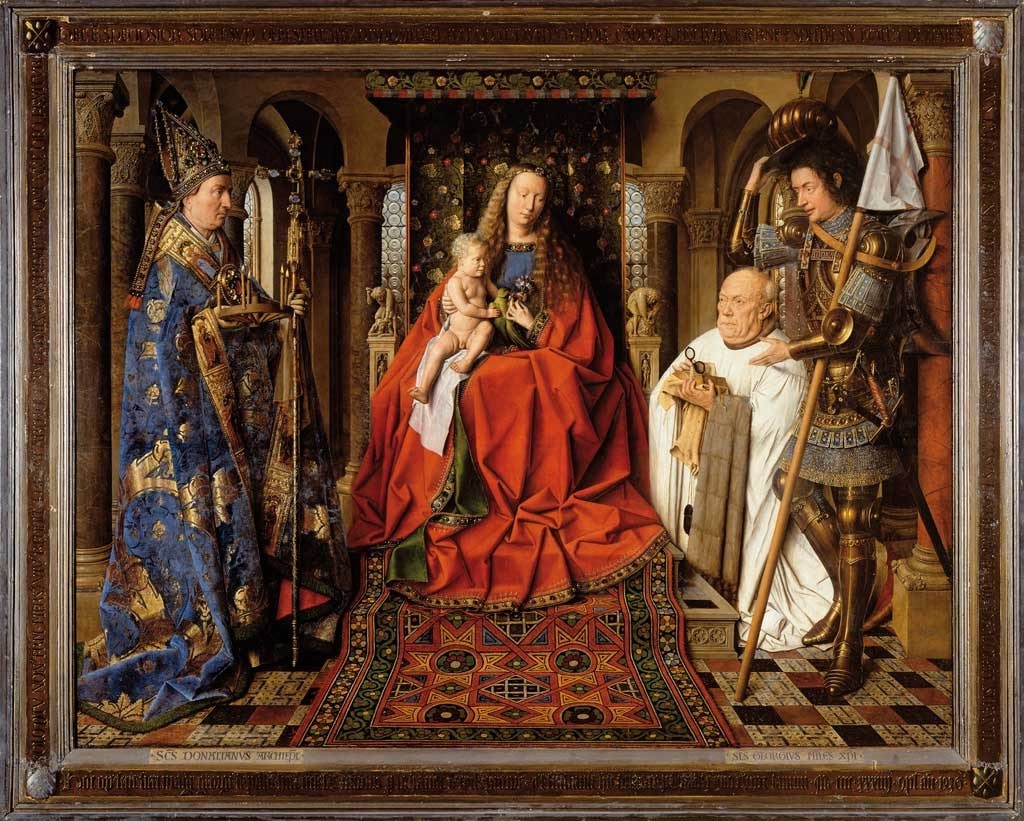
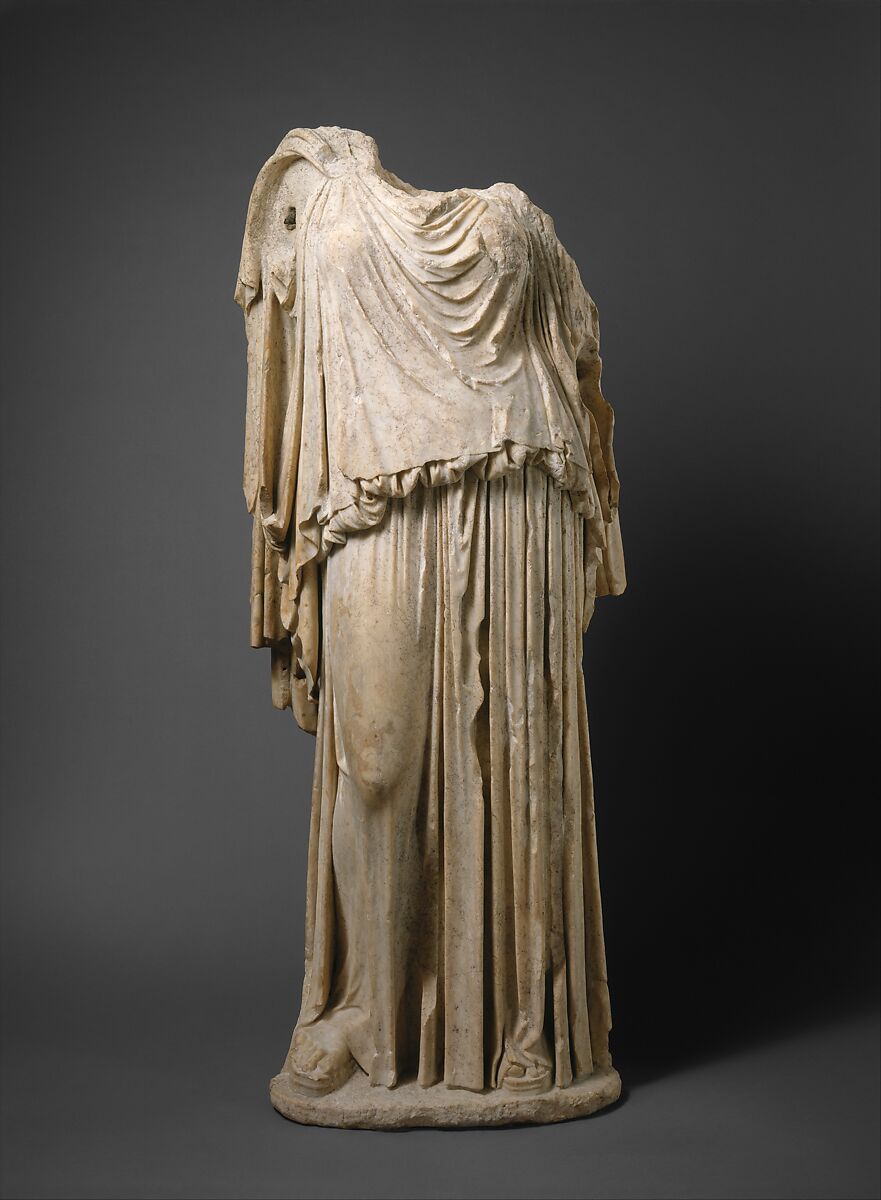
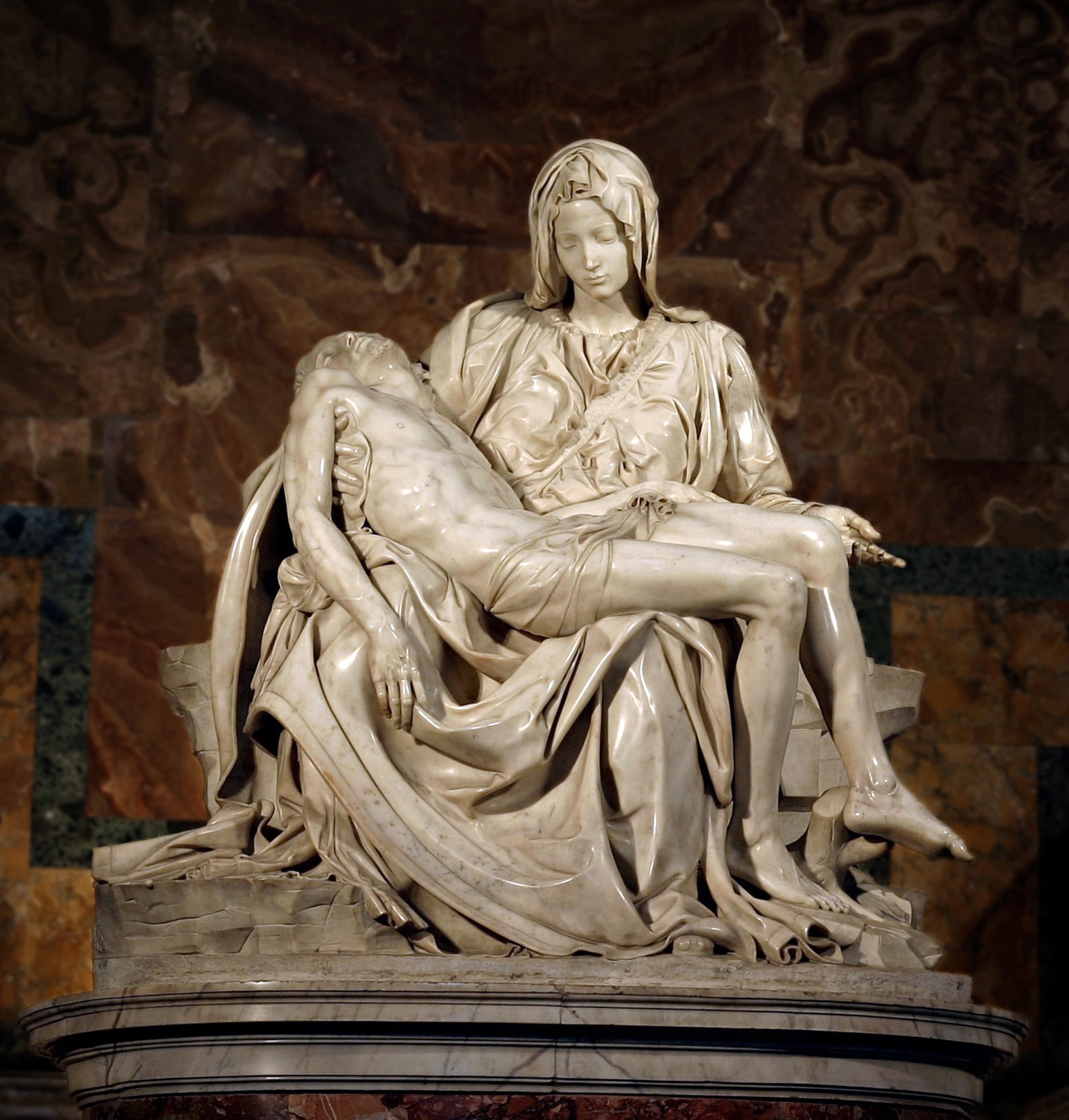
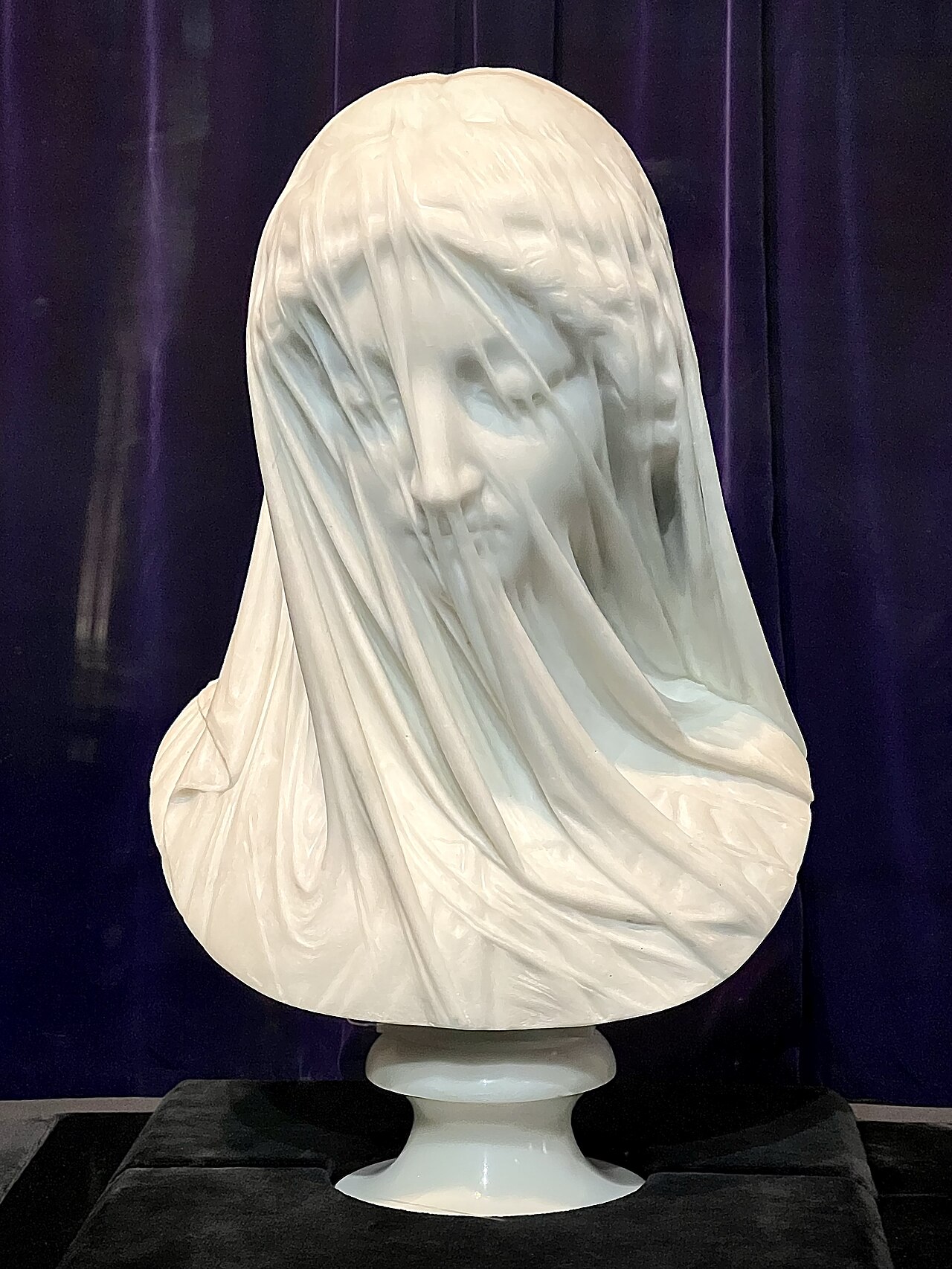
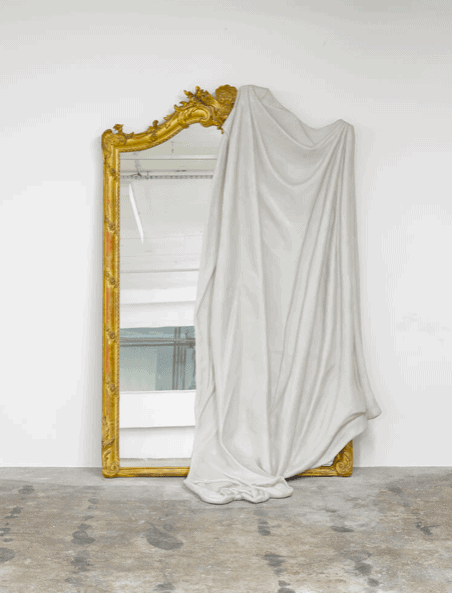
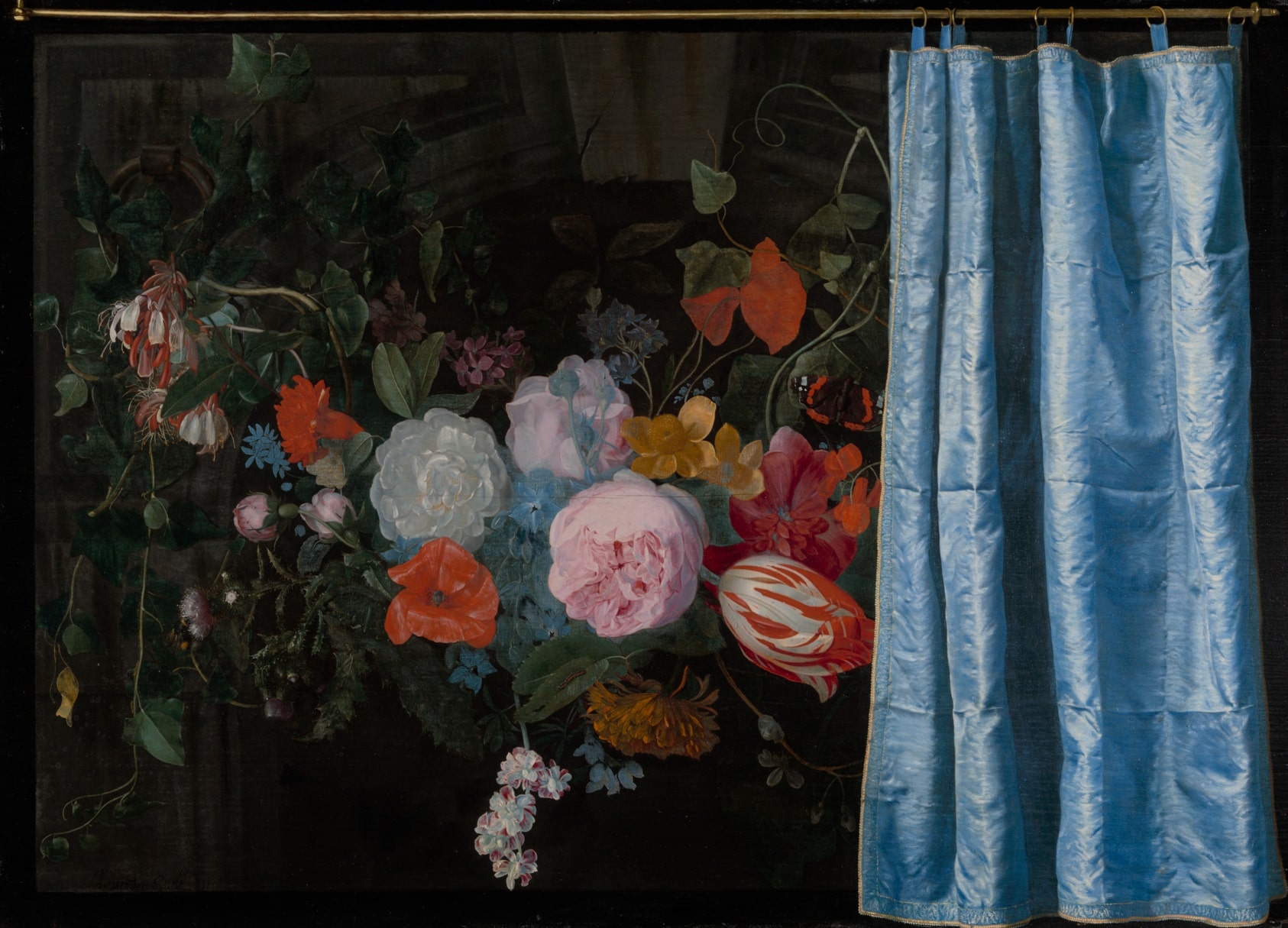

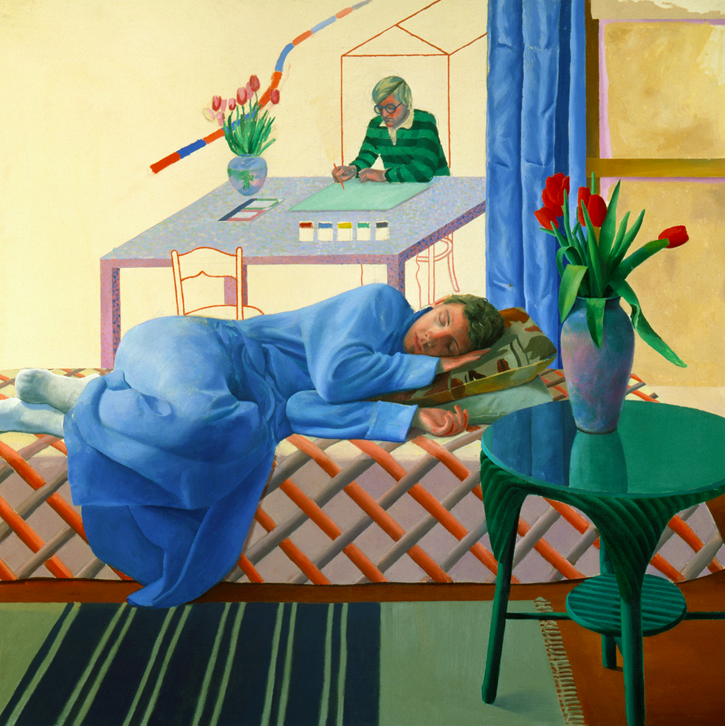


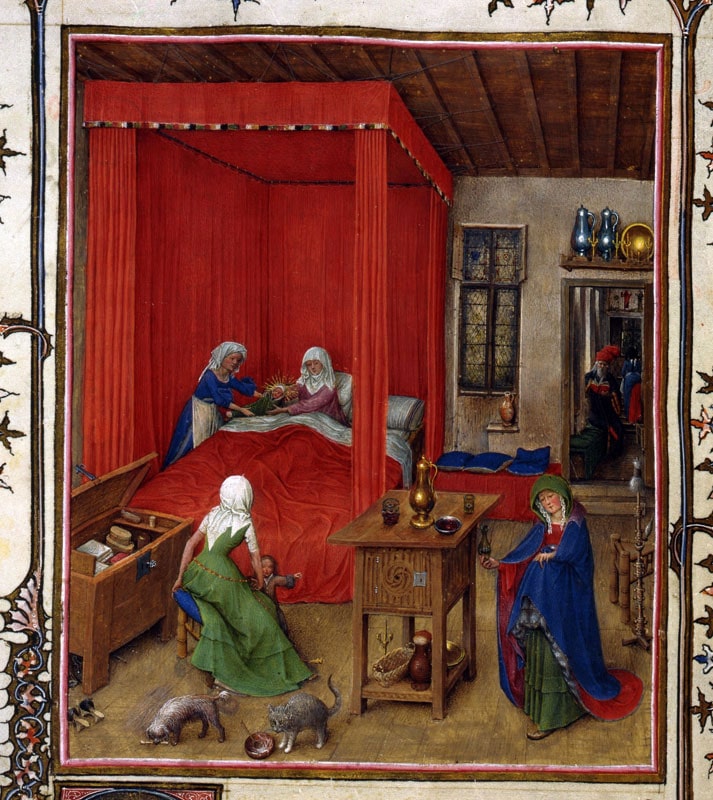
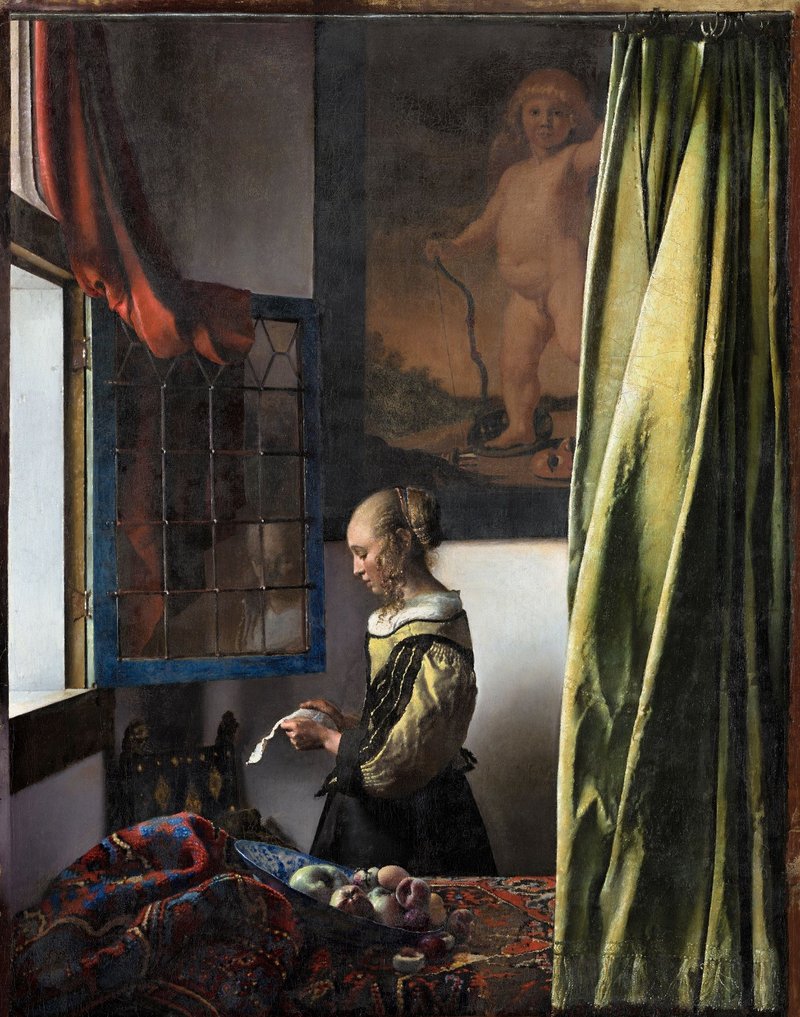
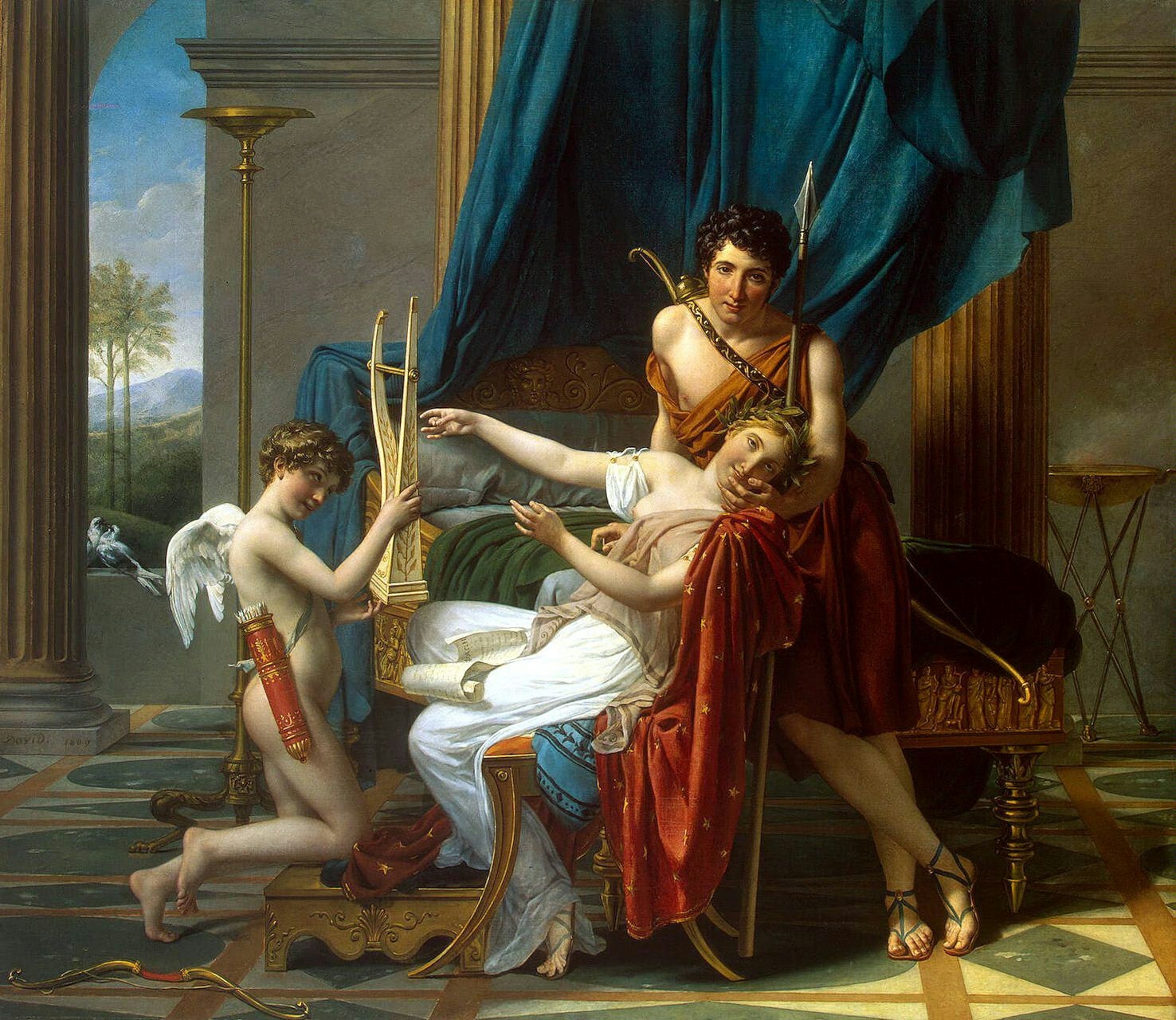
But, in the end, the painting is not a window. And René Magritte’s (1898-1967) pipe is not a pipe—it is a depiction of a pipe. The curtain is, therefore, perhaps both the creator of illusion and the revealer of the so-called treachery of images. So, it is no surprise that the curtain is another key motif of the Belgian surrealist, as he reveals the hollowness of the curtain and the absence of Alberti’s window behind it and simultaneously its function to conceal this inconvenient truth. Magritte was not shy to give away that the painting is just a trick. A notion Gerhard Richter (b. 1932) would revisit in his series of curtains and their uncanny resemblance to his series of corrugated iron and tubes, flirting in the 1960s as a photorealist painter with his inevitable fate of abstraction.
Still, one must remember that Richter’s curtains are titled Vorhang, which literally means “hanging in front.” This brings us to a more romantic, symbolic, or mundane aspect of the curtain: its function to provide privacy, secrecy, intimacy, or discretion. When the drapes are closed, something might happen. And when we are allowed to peek beyond them, we become voyeurs or even participants. Think of the curtained beds in medieval manuscripts or Johannes Vermeer (1632-1675) amplifying the intimacy of a scene of a woman reading a letter—most likely from her husband who is at sea considering the dangerous and expansive Dutch trading activities at the time—by letting us peep beyond that curtain and into her chamber.
Even more, Vermeer has used the curtain for many of the reasons mentioned above: to show his skill, create depth and illusion, or simply because it contributes to the overall composition and color contrast—think of the use of curtains throughout art history as a mere visual element for a more harmonious or more powerful image; exemplified by, for instance, Jacques Louis-David’s (1748-1825) Sappho and Phaon. Interestingly, all these aspects remain present in art today, with some artists opting to make the curtain one of their central motifs or trademarks, as we’ll illustrate by discussing ten must-know contemporary artists leading the trending motif of the curtain today.
1. Christo & Jeanne-Claude
Christo and Jeanne-Claude were renowned for their monumental public art installations, which dramatically transformed familiar landscapes on a temporary basis. Using everyday materials such as fabric, rope, and barrels, their works altered both urban and rural environments, creating unique shared experiences for the public. These large-scale projects often took years of planning and negotiation, existing only for a short time before being dismantled, with the materials either recycled or reused and the sites returned to their original state. The couple collaborated on these installations from 1961 until Jeanne-Claude’s passing in 2009.1
It is safe to say that the same appeal and weight of the drapery and curtains reached new levels to see it on a much larger scale. By wrapping monuments, buildings, bridges, islands, and more, Christo & Jeanne-Claude were creating these dramatic ephemeral entities, dematerializing a building or materializing a valley, giving substance to a negative space. The latter took place on August 10, 1972, in Rifle, Colorado, between Grand Junction and Glenwood Springs in the Grand Hogback Mountain Range with Valley Curtain. An almost immersive intervention using a curtain of almost 400 meters or 1,250 feet.

2. Ulla von Brandenburg
Ulla von Brandenburg, born in 1974 in Karlsruhe, Germany, currently residing and working in Paris, is a contemporary artist working in black-and-white film, installation, performance, drawing, and painting. Central to von Brandenburg’s work is the use of theatrical elements, including stagecraft and performance rules, to engage with cultural and social issues from various historical periods. By examining how past rituals, symbols, and stories shape contemporary society, she explores recurring themes and imagery, continually developing and reinterpreting them.
At the heart of her practice is an exploration of boundaries between different states of consciousness—past and present, life and death, reality and illusion—concepts that naturally result in the prominent inclusion of the curtain.2 It symbolizes a transition from the real world to the world of theater. Beyond the curtain, space and time have no limits. The space is a mental space, a playground of the unconscious, dreams, and imagination.3

3. Louise Giovanelli
Louise Giovanelli, born in 1993 in London, the United Kingodm, residing and working in Manchester, is a contemporary painter that breathes new life into historical subjects from the Western art canon through delicate, luminous paintings. Working in interconnected series, she explores specific moments or events, using visual clues drawn from staged photographs, film stills, classical sculpture, and architectural elements. Her subject matter is chosen for its formal qualities, with motifs often repeated across her series, displaying subtle variations in composition or tonality. Her work is deeply aware of painting’s historical role as both a medium and a system of representation.
Through carefully crafted textures and patterns, she challenges conventional representation, inviting the viewer to engage in a slower, more meditative visual experience. For Giovanelli, painting offers a way to pause and reflect, transforming the act of looking into a contemplative process.4 By looking at Old Masters and uncovering the different layers, she aims to achieve the greatest possible luminosity within this medium, making curtains—from one-colored curtains to disco plastic—an ideal subject. Simultaneously, she always seems to create ambiguity within her imagery by not revealing the full picture. This can occur via drastic cropping strategies, placing one image on top of another, or quite literally with a curtain in the historical tradition of Richter’s Vorhang series, which sets the stage.

4. Dirk Braeckman
Dirk Braeckman, born in 1958 in Eeklo, Belgium, residing and working in Ghent, has built an extensive body of work primarily focused on photography, with more recent explorations in video. His large-scale, grey-toned images are often inspired by chance encounters with everyday scenes, presenting a reality that remains suggestive rather than explicit. His subjects range from distant seascapes and empty ballrooms to billowing curtains, antique wallpaper, and blurred nudes. Braeckman’s work emphasizes atmosphere, composition, light, and texture, creating a poetic experience for the viewer.
Braeckman approaches his darkroom as a painter might approach a studio, using it as a space for experimentation where spontaneity and time play key roles in shaping his creative process. By manipulating negatives through various techniques, his works possess a rare tactile quality that pushes the boundaries of photography. He views photography as the most subjective medium, offering not truth but an endless illusion—making the motif of the curtain once more an ideal stepping stone to achieve his goals.5

5. Edith Dekyndt
Edith Dekyndt, born in 1960 in Ypres, Belgium, residing and working between Brussels and Berlin, is a multidisciplinary artist working in video, sculpture, installation, drawing, and sound, exploring timeless themes of light, time, and space in subtle and nuanced ways. Dekyndt’s work demonstrates a deep fascination with physical phenomena and fleeting moments, often focusing on the transient qualities of materials. Through her keen attention to sensory experiences, she develops a visually engaging and conceptually rich language that reflects the delicate interplay between materiality and perception.6
On numerous occasions, the curtain has been used for her installations, by, for instance, letting the moisture from the floor creep its way up against gravity and those vertical drapes, creating almost archeological layers of decay and wear. But also by perforating a large velvet curtain with nails, creating a stark contrast between the cool hardness of the nails and piercing a delicate fabric. This particular installation references both the iron curtain that blocks the Centre’s entrance and the way that fences are raised everywhere in the world.7

6. Patty Carroll
Patty Carroll, born in 1946 in Chicago, where the artist continues to work and reside, is an acclaimed photographer known for her vivid, highly saturated color images and the strong presence of drapery and curtains. Even more, her work has been copied or misused as source material by a vast number of less-known painters drawn to the depiction of curtains, illustrating both the power of her imagery and simultaneously the shameless desire and appropriation from artists across the globe to depict fabric.
In her breakthrough series Anonymous Women, she explores women’s complex relationships with domesticity by camouflaging the female figure with drapery and domestic objects, creating a dark yet humorous dynamic of concealment. The Anonymous Woman becomes both a victim of and an invisible creator within her environment, embodying themes of obsession, activity, and circumstance.8

7. Mircea Suciu
Mircea Suciu, born in 1978 in Baia Mare, Romania, lives and works in Cluj-Napoca. His work is often focused on themes of anxiety, violence, and oppression. Through an eclectic selection of imagery, Suciu seeks to create iconic representations in a world saturated with visual content. By doing so, the artist reflects a deep interest in how images can be manipulated and their impact on society, shaped by his upbringing under a Communist dictatorship.
From this perspective, the curtain, and drapery in general, becomes an important visual element and symbolic construct in his artistic practice. Think of his Iron Curtain series dealing with his political background or using the curtain to explore more psychological issues with a universal or collective appeal.9

8. Justin Morin
Justin Morin, born in 1979 in Mont Saint Martin, France, residing and working in Paris, is a contemporary artist and designer who is best known for his sculptures, primarily using steel and silk, creating curtains playing with the color spectrum, transparency, and form. His work references a wide range of artistic traditions, from minimalism to the light and space movement.
Morin’s approach to sculpture emphasizes the expressive qualities of his materials, introducing a sensual, almost erotic dimension to an otherwise minimalist aesthetic. He often employs gradient compositions, with influences spanning from fashion advertising to movie posters. By blending elements of art, fashion, and design, his work occupies an ambiguous space between the conceptual and the decorative.10

9. Ilke Cop
Ilke Cop, born in 1988, residing and working in Brussels, Belgium, is a contemporary artist and art historian working in painting and sculpture. She is best known for her enigmatic and often surreal paintings, filled with nudes, self-portraits, mushrooms, landscapes, and the pertinent presence of drapery, questioning the classical image of man and the world and the role of contemporary (female) artists.
It is no surprise to see such a strong presence of curtains and drapery in her painterly and sculptural practice, as Cop ran the acclaimed and sustainable fashion label ILKECOP until 2021. Cop uses colored curtains as visual anchor points throughout her oeuvre, creating an intimate environment or a screen for her subjects and composition.11

10. Shawn Huckins
Shawn Huckins, born in 1984 in New Hampshire, residing and working in Denver, the United States of America, is a contemporary painter recognized for his fusion of technical precision and satirical humor. His work reimagines classical American art, often incorporating textiles, fabrics, curtains, and text to reflect both an appreciation for American history and a critique of contemporary society. Through his paintings, Huckins explores and challenges modern culture, critiquing politics, masculinity, social media, and personal identity with a distinctly millennial perspective.12
Drapery became increasingly important during his series titled Dirty Laundry, giving a satirical but poignant spin on Ewa Juszkiewicz’s (b. 1985) successful formula of wrapping faces and figures in textile and fabric but replacing the historical and dramatic drapery with dirty laundry, questioning the security of our own concealments. Even more, in Zippers Short and Skinny, silky fabrics and hand-woven latch hook textiles merge with historical paintings of men and boys to confront the effects of rigid gender norms, which not only restrict the emotional expression and personal growth of individuals but also contribute to systemic issues such as violence, discrimination, and inequality—a series marked by curtain paintings from which a figure or hand emerges, or doesn’t emerge.13

36 × 30 in | 91.4 × 76.2 cm. Courtesy Richard Heller Gallery.
Notes:
- Gagosian, Christo and Jeanne-Claude at https://gagosian.com/artists/christo/ consulted September 5, 2024. ↩︎
- Pilar Corrias, Ulla von Brandenburg at https://www.pilarcorrias.com/artists/37-ulla-von-brandenburg/ consulted September 5, 2024. ↩︎
- Cecession, Ulla von Brandenburg – Innen ist nicht AuSSen at https://secession.at/ausstellung_ulla_von_brandenburg_en consulted September 6, 2024. ↩︎
- GRIMM, Louise Giovanelli at https://grimmgallery.com/artists/73-louise-giovanelli/ consulted September 5, 2024. ↩︎
- GRIMM, Dirk Braeckman at https://grimmgallery.com/artists/82-dirk-braeckman/ consulted September 5, 2024. ↩︎
- Galerie Greta Meert, Edith Dekyndt at https://galeriegretameert.com/artists/edith-dekyndt/ consulted September 5, 2024. ↩︎
- Edith Dekyndt, They Shoot Horses at https://edithdekyndt.be/they-shoot-horses/ consulted September 6, 2024. ↩︎
- BBA Gallery, Patty Carroll at https://www.bba-gallery.com/patty-carroll?srsltid=AfmBOoo6JHzSXQOcWRZh16Qc62jeeMdTI7F_Kz1-sUz7QKL1OyIUTmNL consulted September 5, 2024. ↩︎
- Mennour, Mircea Suciu at https://mennour.com/artists/mircea-suciu consulted September 5, 2024. ↩︎
- The Collectional, Justin Morin at https://thecollectional.com/blogs/artists/justin-morin?srsltid=AfmBOoqZ8589S-KVtkIwz7SCEx-6oo6yM0SGSkeJp-p5fvF_XyrwJEn9https://thecollectional.com/blogs/artists/justin-morin?srsltid=AfmBOoqZ8589S-KVtkIwz7SCEx-6oo6yM0SGSkeJp-p5fvF_XyrwJEn9 consulted September 5, 2024. ↩︎
- Ilke Cop, Bio at https://www.ilkecop.com/bio consulted September 5, 2024. ↩︎
- Shawn Huckins, Bio at https://shawnhuckins.com/page/1-Bio.html consulted September 5, 2024. ↩︎
- Shawn Huckins, Dirty Laundry and Zippers Short and Skinny at https://shawnhuckins.com/section/509053-Dirty%20Laundry.html and https://shawnhuckins.com/section/525307-Zippers%20Short%20and%20Skinny.html consulted September 6, 2024. ↩︎
Last Updated on April 15, 2025
About the author:
- Tags: CONTEMPORARY ART HISTORY, HOME


